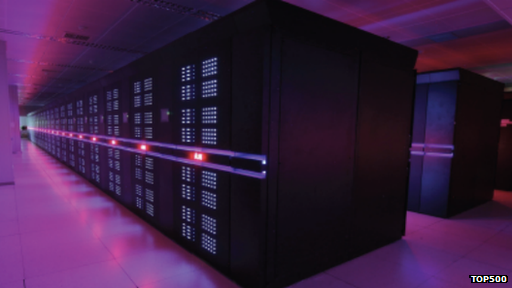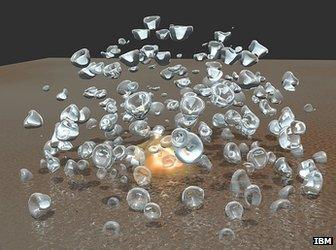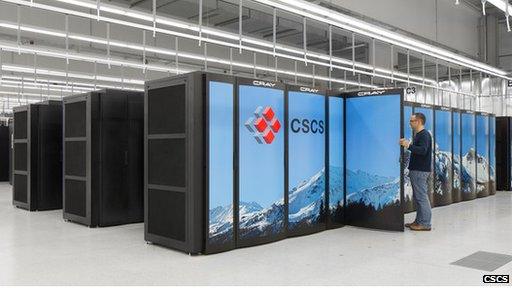China retains supercomputer crown in latest Top500 list
- Published

China's Tianhe-2 held on to the top spot which it had first secured in June
A supercomputer built by the Chinese government has retained its place at the top of a list of the world's most powerful systems.
Tianhe-2 can operate at 33.86 petaflop/s - the equivalent of 33,863 trillion calculations per second - according to a test called the Linpack benchmark.
There was only one change near the top of the leader board.
Switzerland's new Piz Daint - with 6.27 petaflop/s - made sixth place.
The Top500 list is compiled twice-yearly by a team led by a professor from Germany's University of Mannheim.
It measures how fast the computers can solve a special type of linear equation to determine their speed, but does not take account of other factors - such as how fast data can be transferred from one part of the system to another - which can also influence real-world performance.
IBM - which created five out of the 10 fastest supercomputers in the latest list - told the BBC it believed the way the list was calculated should now be updated, and would press for the change at a conference being held this week in Denver, Colorado.
"The Top500 has been a very useful tool in the past decades to try to have a single number that could be used to measure the performance and the evolution of high-performance computing," said Dr Alessandro Curioni, head of the computational sciences department at IBM's Zurich research lab.
"[But] today we need a more practical measurement that reflects the real use of these supercomputers based on their most important applications.
"We use supercomputers to solve real problems - to push science forward, to help innovation, and ultimately to make our lives better.
"So, one thing that myself and some of my colleagues will do is discuss with the Top500 organisers adding in new measurements."
However, one of the list's creators suggested the request would be denied.
"A very simple benchmark, like the Linpack, cannot reflect the reality of how many real application perform on today's complex computer systems," said Erich Strohmaier.
"More representative benchmarks have to be much more complex in their coding, their execution and how many aspects of their performance need to be recorded and published. This makes understanding their behaviour more difficult.
"Finding a good middle-ground between these extremes has proven to be very difficult, as unfortunately all previous attempts found critics from both camps and were not widely adopted."
China's lead
Tianhe-2 - which translates as Milky Way 2 - was developed by China's National University of Defence Technology and will be based in the city of Guangzhou, in the country's south-eastern Guandong province.

IBM's Sequoia recently carried out a simulation of a cloud of 15,000 bubbles
It uses a mixture of processors made by Intel as well as custom-made CPUs (central processing units) designed by the university itself.
The system is to be offered as a "research and education" tool once tests are completed, with local reports suggesting that officials have picked the car industry as a "priority" client.
Its Linpack score is nearly double that of the next supercomputer in the list - Titan, the US Department of Energy's system at the Oak Ridge National Laboratory in Tennessee.
However, one expert said it was still too early to know whether the Chinese system would be able to outperform its US counterpart in real-world tasks.
"You can get bottlenecks," said Prof Alan Woodward, from the University of Surrey's department of computing.
"Talking about the number of calculations that can be carried out per second isn't the same as saying a supercomputer can do that in practice in a sustained way. The processors might be kicking their heels some of the time if they don't get the data as fast as they can handle, for example."
Energy efficiency
Supercomputer applications do not tend to use all the processor power on offer.
IBM notes that its own Sequoia supercomputer - which came third on the latest list - used a relatively high 73% of the machine's theoretical peak performance when it recently carried out what the firm describes as the biggest ever fluid dynamics simulation to date.

Switzerland's Piz Daint will be used to model galaxy formations and weather patterns
The test involved creating virtual equivalents of 15,000 collapsing bubbles - something researchers are studying to find new ways to destroy kidney stones and cancerous cells.
"The thing you want to avoid is to throw away resources," reflected Dr Curioni.
"For scientists, the most important thing is how fast you solve a problem using the machine in an efficient way.
"When we run these types of simulations we invest much larger amounts of money running the machines than buying them."
He added that one of the biggest costs involved is energy use.
According to the Top500 list, Tianhe-2 requires 17,808 of kW power - more than double the 8,209 kW needed by Titan or the 7,890 kW needed by Sequoia.
Dr Curioni believes a revised leader board should take energy efficiency into account.
But Prof Woodward agreed with the list's creators that getting researchers and the governments that sponsored them to agree to a new methodology might be easier said than done.
"There is a lot of kudos in having what is termed the fastest supercomputer," he said.
"So, there will be resistance to a definition that favours one computer over another."
- Published17 June 2013
- Published18 October 2013
- Published15 October 2013